Hasson Park
- Judy Etzel
- July 2, 2021
- Hidden Heritage
- 3133
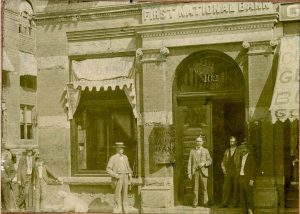
Capt. William Hasson, a Civil War veteran, is shown in front of the First National Bank at the corner of Seneca and Center streets. The oil baron was president of the bank and served as a director for most of his life.
How about calling it the Peoples Park? Or maybe, Petroleum Park? What about Honeysuckle Hill Park?
Those were just a few of the names suggested for what would become a sprawling and beautiful urban park established 125 years ago in the City of Oil City. The 48-acre tract was offered free of charge to the city on August 12, 1895, by oilman and banker William Hasson who stipulated that the park could never be commercialized in any way and must remain a free and natural recreation area for everyone in the community.
He had another stipulation, too, and that involved the name for the park. Hasson, a Civil War veteran who returned to Oil City after being seriously wounded in battle, bought numerous properties in what would become the City of Oil City in 1871. One such purchase included 48 acres for a community park and an adjacent 25 acres for a fairground to offer horse races.
Neither property, he insisted, should be named for him.
In response, the Blizzard newspaper in Oil City asked readers to submit possible names for the new park. The list was lengthy but no entry found favor with a newly created park commission consisting of P.C. Boyle, Eugene Liebel and F.W. Bowen. At a meeting in the Oil Exchange, the trio decided to put Hasson’s objection aside and name the property Hasson Park.
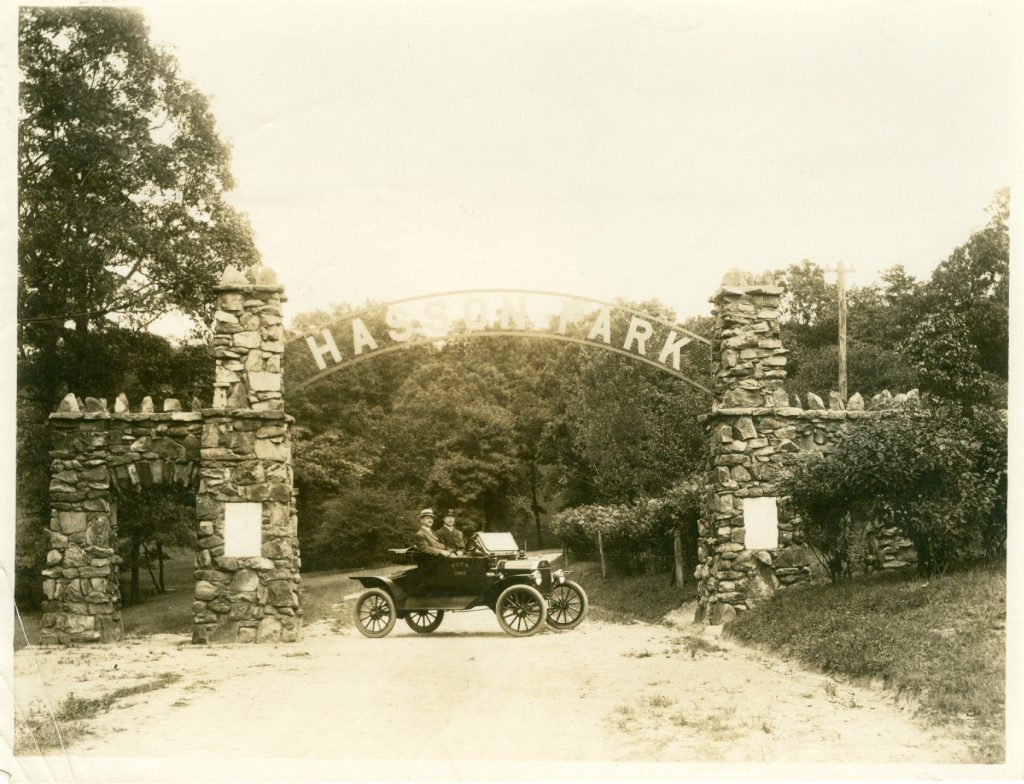
The elaborate wrought-iron arch at Hasson Park’s main entrance was dedicated on May 13, 1913. It was replaced in 2015 with a custom-made steel arch.
On July 4, 1896, the park was officially dedicated by Oil City Mayor James Fawcett. The ceremony featured 50 young ladies singing under the direction of Estelle Brokaw, foot and bicycle races throughout the downtown business district, speeches in the park and an illuminated bicycle parade at night inside the park.
At the same time, a campaign was launched to raise money to install a park road and make other improvements.
“The response was good,” reported The Blizzard newspaper. “Ladies, though, should understand that ‘women’s rights’ go in this case. They can contribute as well as the men, if they feel inclined to do so. … Let each one give according to his or her means.”
While that work moved ahead, the park commission asked residents to pitch in $1 each to pay for an ornate and main entrance to the park. No one was permitted to give more than $1 each with the final collection paying for two pillars of stone, 18 feet high and all culled from within the park, and a curved wrought iron sign that said Hasson Park.
That campaign, too, was successful. The pillars and archway, described in news accounts as “one of the most graceful specimens of architecture to be found anywhere,” were formally dedicated May 13, 1913. In what the newspapers termed as “an unostentatious ceremony” attended by hundreds, park officials inserted a copper box in one of the stone pillars. The contents included a list of 425 individuals who contributed $1 each, a roster of city officials, copies of The Derrick and The Blizzard newspapers, a Lincoln cent and Buffalo nickel. Included in the collection was a last minute deposit of a packet of gum, curiously described in a newspaper article about the dedication as “the makings of the ‘cud of reflection’.”
The archway eventually deteriorated and was replaced in 2015 with a custom-made stainless steel arch by the Oil City Heritage Society.
Hillside of Blooms
The Rhododendron Arboretum in Hasson Park is a unique attraction within the park. The extensive hillside collection features more than 500 plants in 25 varieties. The Oil City Garden Club designed the arboretum in 1961 and expanded the collection over the years to offer white and several shades of pink and red plants that cascade down the hillside. The color and planting designs mirror the Royal Windsor Garden in England. Leading the project were Garden Club members Winnie Brown, Lois Hayes and Barbara McKinley. Included in the arboretum setting was a 20-foot circular geodesic dome, personally designed by R. Buckminster Fuller, internationally known architect, innovator and scientist. Created for a national flower show in 1975, the dome was offered to anyone submitting a practical, imaginative idea for its use in a horticultural setting. It was won by Eleanor Corrin who suggested the dome be installed in Hasson Park. It was made of Philippine mahogany pieces and, when assembled, was described as a park sculpture. It eventually deteriorated and was removed in the early 1990s.
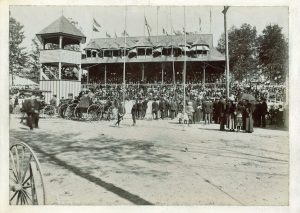
Land adjacent to Hasson Park was turned into a first class trotters’ race track. It operated from 1898 to 1909 under the auspice of the County Fair and Trotting Association.
The Other Property
Hasson also gave the city an adjacent 25-acre property to be used as a “first class trotters’ race track.” It opened on June 14, 1898, and featured a grandstand, track, judges’ tower and entertainment platform. The races were sponsored by the County Fair and Trotting Association.
Only four fairs were ever held at the location and eventually the buildings were sold as a result of mortgage foreclosures. While a few more races were held, the last trotters on the oval track were in 1909. The property later became the city’s youth ballfields.
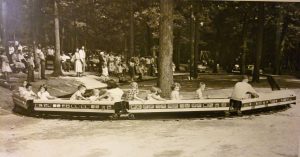
A new attraction was introduced in Oil City’s Hasson Park on July 23, 1950. It was a miniature passenger train that traveled an oval track in the park.
In addition to the flower gardens, fountains, playgrounds and more, Hasson Park had an unusual draw – a small scale passenger train in the 1950s. The train was owned by Joy Enterprises, a small company that was also responsible for the park’s miniature golf course and food concessions at the city swimming pool. Jim Schwab managed the summer attractions while the train engineer was Jim Hicks who would later become director of the city’s public works department. High school students were hired to manage the train. The train, consisting of three passenger cards, an engine and steel track, were later sold to the St. Petersburg Volunteer Fire Department.
Hasson Park annually draws thousands of visitors who hold family gatherings, school and scout functions and class reunions in the sprawling park.
Property for Sale
The city park also was featured in real estate advertisements. A 1918 ad was headlined “Up Where the Sun Shines” and promoted “the only residential district in Oil City with building restrictions.” The lots were on Hasson and Linden avenues, parcels that were “located away from the noise of the city where the air is pure and your family can enjoy the many advantages of Hasson Park, the beauty spot of Oil City.” There were 67 lots laid out and 19 remained unsold. Each lot had sewer, water and gas services and were accessible to street car access every 20 minutes. The Johnston Hall and Willard Howe real estate office at 205 Sycamore St. was handling the sale of the lots. They offered that they would accept “Liberty Bonds in payment or $10 down and $10 a month.”
Andrew Short
The man who served as Oil City’s lead organizer for the Hasson Park project would eventually have a city park named after him.
Andrew J. Short, a city native, was appointed city street commissioner in 1886 by Mayor Fawcett. He and his wife, Anna, and their family lived at 219 Hone Ave. In the very early stages of developing what would become Hasson Park, Short was tasked with arranging for a park road and entranceways to be built, flower gardens and ornamental trees to be planted and other amenities, including a concession stand, miniature golf course and fountains, to be installed.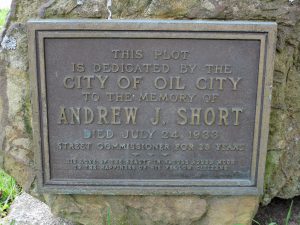
When he died at age 80 in 1933, The Derrick newspaper eulogized him:
“Andy Short was a lover of nature and beauty. To him, this city owes the charm and the uplifting influence of many little beauty spots – corners and circles which Andy had filled with rich earth and made to bloom with flowers, grass and shrubbery.
“Children watched his tender ministrations to Mother Earth and because they loved Andy so much as Andy loved flowers, they respected the privacy of his plots and watched them blossom into beauty patches where ugliness might have prevailed.
“This is why we say the city owes a debt to the memory of Andrew J. Short. May the work he started be carried on with the same fervor and fidelity.”
To that end, the city dedicated the Andrew J. Short Memorial Park on November 11, 1933. The park, located at the intersection of Manning and Gay streets, featured flower beds, a rock garden, a flagpole and a large boulder featuring a bronze plaque in his memory.
Written by Judy Etzel with research by Kay Dawson and design by Natalie Cubbon.

Capt. William Hasson, a Civil War veteran, is shown in front of the First National Bank at the corner of Seneca and Center streets. The oil baron was president of the bank and served as a director for most of his life.
How about calling it the Peoples Park? Or maybe, Petroleum Park? What about Honeysuckle Hill Park?
Those were just a few of the names suggested for what would become a sprawling and beautiful urban park established 125 years ago in the City of Oil City. The 48-acre tract was offered free of charge to the city on August 12, 1895, by oilman and banker William Hasson who stipulated that the park could never be commercialized in any way and must remain a free and natural recreation area for everyone in the community.
He had another stipulation, too, and that involved the name for the park. Hasson, a Civil War veteran who returned to Oil City after being seriously wounded in battle, bought numerous properties in what would become the City of Oil City in 1871. One such purchase included 48 acres for a community park and an adjacent 25 acres for a fairground to offer horse races.
Neither property, he insisted, should be named for him.
In response, the Blizzard newspaper in Oil City asked readers to submit possible names for the new park. The list was lengthy but no entry found favor with a newly created park commission consisting of P.C. Boyle, Eugene Liebel and F.W. Bowen. At a meeting in the Oil Exchange, the trio decided to put Hasson’s objection aside and name the property Hasson Park.

The elaborate wrought-iron arch at Hasson Park’s main entrance was dedicated on May 13, 1913. It was replaced in 2015 with a custom-made steel arch.
On July 4, 1896, the park was officially dedicated by Oil City Mayor James Fawcett. The ceremony featured 50 young ladies singing under the direction of Estelle Brokaw, foot and bicycle races throughout the downtown business district, speeches in the park and an illuminated bicycle parade at night inside the park.
At the same time, a campaign was launched to raise money to install a park road and make other improvements.
“The response was good,” reported The Blizzard newspaper. “Ladies, though, should understand that ‘women’s rights’ go in this case. They can contribute as well as the men, if they feel inclined to do so. … Let each one give according to his or her means.”
While that work moved ahead, the park commission asked residents to pitch in $1 each to pay for an ornate and main entrance to the park. No one was permitted to give more than $1 each with the final collection paying for two pillars of stone, 18 feet high and all culled from within the park, and a curved wrought iron sign that said Hasson Park.
That campaign, too, was successful. The pillars and archway, described in news accounts as “one of the most graceful specimens of architecture to be found anywhere,” were formally dedicated May 13, 1913. In what the newspapers termed as “an unostentatious ceremony” attended by hundreds, park officials inserted a copper box in one of the stone pillars. The contents included a list of 425 individuals who contributed $1 each, a roster of city officials, copies of The Derrick and The Blizzard newspapers, a Lincoln cent and Buffalo nickel. Included in the collection was a last minute deposit of a packet of gum, curiously described in a newspaper article about the dedication as “the makings of the ‘cud of reflection’.”
The archway eventually deteriorated and was replaced in 2015 with a custom-made stainless steel arch by the Oil City Heritage Society.
Hillside of Blooms
The Rhododendron Arboretum in Hasson Park is a unique attraction within the park. The extensive hillside collection features more than 500 plants in 25 varieties. The Oil City Garden Club designed the arboretum in 1961 and expanded the collection over the years to offer white and several shades of pink and red plants that cascade down the hillside. The color and planting designs mirror the Royal Windsor Garden in England. Leading the project were Garden Club members Winnie Brown, Lois Hayes and Barbara McKinley. Included in the arboretum setting was a 20-foot circular geodesic dome, personally designed by R. Buckminster Fuller, internationally known architect, innovator and scientist. Created for a national flower show in 1975, the dome was offered to anyone submitting a practical, imaginative idea for its use in a horticultural setting. It was won by Eleanor Corrin who suggested the dome be installed in Hasson Park. It was made of Philippine mahogany pieces and, when assembled, was described as a park sculpture. It eventually deteriorated and was removed in the early 1990s.

Land adjacent to Hasson Park was turned into a first class trotters’ race track. It operated from 1898 to 1909 under the auspice of the County Fair and Trotting Association.
The Other Property
Hasson also gave the city an adjacent 25-acre property to be used as a “first class trotters’ race track.” It opened on June 14, 1898, and featured a grandstand, track, judges’ tower and entertainment platform. The races were sponsored by the County Fair and Trotting Association.
Only four fairs were ever held at the location and eventually the buildings were sold as a result of mortgage foreclosures. While a few more races were held, the last trotters on the oval track were in 1909. The property later became the city’s youth ballfields.

A new attraction was introduced in Oil City’s Hasson Park on July 23, 1950. It was a miniature passenger train that traveled an oval track in the park.
In addition to the flower gardens, fountains, playgrounds and more, Hasson Park had an unusual draw – a small scale passenger train in the 1950s. The train was owned by Joy Enterprises, a small company that was also responsible for the park’s miniature golf course and food concessions at the city swimming pool. Jim Schwab managed the summer attractions while the train engineer was Jim Hicks who would later become director of the city’s public works department. High school students were hired to manage the train. The train, consisting of three passenger cards, an engine and steel track, were later sold to the St. Petersburg Volunteer Fire Department.
Hasson Park annually draws thousands of visitors who hold family gatherings, school and scout functions and class reunions in the sprawling park.
Property for Sale
The city park also was featured in real estate advertisements. A 1918 ad was headlined “Up Where the Sun Shines” and promoted “the only residential district in Oil City with building restrictions.” The lots were on Hasson and Linden avenues, parcels that were “located away from the noise of the city where the air is pure and your family can enjoy the many advantages of Hasson Park, the beauty spot of Oil City.” There were 67 lots laid out and 19 remained unsold. Each lot had sewer, water and gas services and were accessible to street car access every 20 minutes. The Johnston Hall and Willard Howe real estate office at 205 Sycamore St. was handling the sale of the lots. They offered that they would accept “Liberty Bonds in payment or $10 down and $10 a month.”
Andrew Short
The man who served as Oil City’s lead organizer for the Hasson Park project would eventually have a city park named after him.
Andrew J. Short, a city native, was appointed city street commissioner in 1886 by Mayor Fawcett. He and his wife, Anna, and their family lived at 219 Hone Ave. In the very early stages of developing what would become Hasson Park, Short was tasked with arranging for a park road and entranceways to be built, flower gardens and ornamental trees to be planted and other amenities, including a concession stand, miniature golf course and fountains, to be installed.
When he died at age 80 in 1933, The Derrick newspaper eulogized him:
“Andy Short was a lover of nature and beauty. To him, this city owes the charm and the uplifting influence of many little beauty spots – corners and circles which Andy had filled with rich earth and made to bloom with flowers, grass and shrubbery.
“Children watched his tender ministrations to Mother Earth and because they loved Andy so much as Andy loved flowers, they respected the privacy of his plots and watched them blossom into beauty patches where ugliness might have prevailed.
“This is why we say the city owes a debt to the memory of Andrew J. Short. May the work he started be carried on with the same fervor and fidelity.”
To that end, the city dedicated the Andrew J. Short Memorial Park on November 11, 1933. The park, located at the intersection of Manning and Gay streets, featured flower beds, a rock garden, a flagpole and a large boulder featuring a bronze plaque in his memory.
Written by Judy Etzel with research by Kay Dawson and design by Natalie Cubbon.
